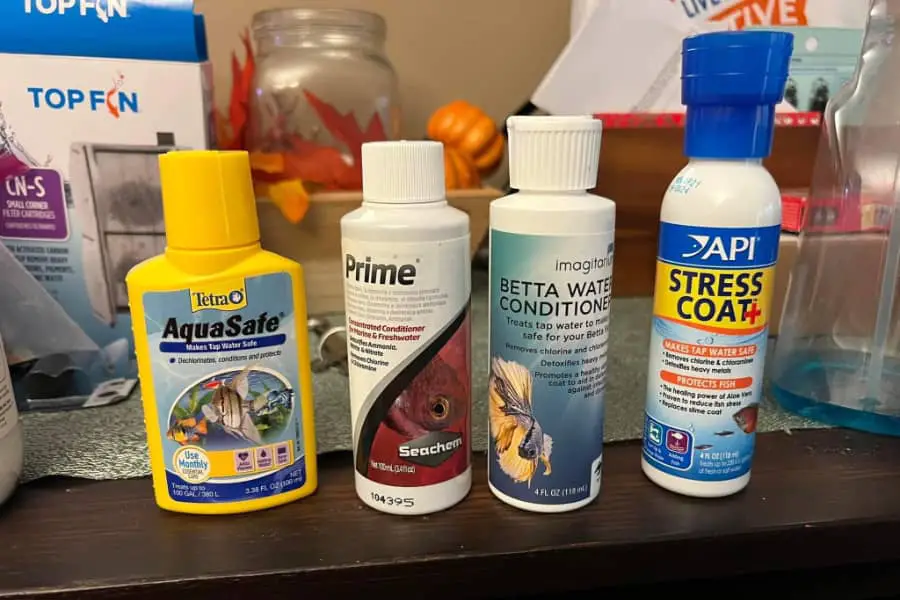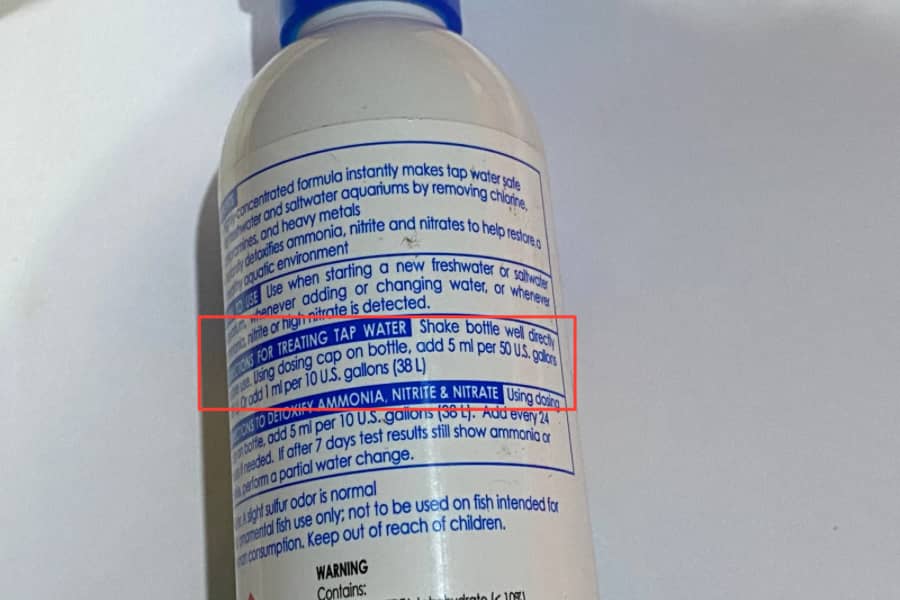Can Too Much Water Conditioner Kill Fish? Here’s The Truth!
When people buy fish, they want to make sure the fish are safe and that the water they swim in is clean. Adding a water conditioner to a fish tank neutralizes the chlorine in the water. This makes it safe for fish to swim in, but can too much water conditioner kill fish instead of keeping their water safe?
Well, in this article we will discuss if too much water conditioner bad for fish or not. The rest of this article will cover a few areas of interest related to this topic, including:
- The three types of water conditioners
- How water conditioner helps fish
- How water conditioner harms fish
- How much water conditioner you should use
- What to avoid when using water conditioner
Can Too Much Water Conditioner Kill Fish?

Too much water conditioner can kill fish. That said, not using a water conditioner is far more likely to kill a fish than using too much water conditioner. Realistically speaking, adding a water conditioner to your fish tank will not kill your fish unless you grossly exceed the recommended dosage.
If you have poisoned your fish by adding too much water conditioner to your fish tank, then you should immediately remove the fish and place them in a new cycled tank with dechlorinated water.
You can also do a partial water changes in the main tank to remove excess water conditioner.
To prevent fish poisoning from adding too much water conditioner, it is always recommended to follow product dose instructions carefully. How much to add water conditioner in a fish tank may differ by brands.
Types of Water Conditioners
Water conditioners neutralize the chlorine in the water. They serve other purposes as well, though, including tackling ammonia and heavy metals that can also harm fish. Using a water conditioner in your freshwater tank is an integral part of ensuring your fish can survive.
Here are the three types of water conditioners you can buy for freshwater fish tanks:
- Dechlorinators – Get rid of chlorine in water but not chloramine
- Chloramine Neutralizers – Neutralize ammonia; Break down chloramine
- Complete Water Conditioners – Perform double duty to tackle both chlorine and ammonia and even heavy metals
If you’re looking for an all-in-one water conditioner that removes ammonia, chlorine, and chloramine, this Seachem Prime Fresh And Salt Water Conditioner (available on Amazon.com) is an excellent option. If in doubt about what type of water conditioner is best for your fish and your particular fresh water tank, it’s best to ask a fish specialist at your fish store. They’ll be able to point you in the right direction.
How Does a Water Conditioner Help Fish?
Why do we even need a water conditioner? The answer is pretty simple. The very minerals and metals, and chemicals that make it possible for us to drink tap water can make it deadly for fish.
Adding a conditioner to water ensures fish can live safely in a freshwater tank. Think of it kind of like oxygen. We need oxygen to breathe. Fish need water without harmful chemicals.
What Exactly Does a Water Conditioner Do?
If you think about the term “conditioner,” it’s not difficult to figure out what it does for fish. It moistens their skin and scales. In short, it keeps fish slimy. That’s a good thing! That’s not its main purpose, though. The main reason to use a water conditioner is to remove chlorine, ammonia, and chloramine from tap water, which can kill fish.
Knowing how much to use and when to use a water conditioner in your fish tank is important to ensuring your fish gets just the right amount needed for health and safety.
Let’s see a few helpful guidelines for ensuring your water conditioner helps your fish rather than harming it.
Add Water Conditioner to the Tank Before You Add the Fish
Adding a water conditioner to the fish tank before adding fish is easiest when you first buy the tank. Adding the conditioner removes the chlorine components that can harm your fish, providing an immediate safe home for your fish to acclimate happily.
Things get a bit trickier as time goes on. This is when you move beyond tank set-up and tank maintenance.
How Often Should You Clean the Tank?
As a general rule, you should clean your freshwater fish tank once per week. If you have a filter, you may be able to go for several weeks without changing the water. It’s not easy to remove fish from the tank to do this. In fact, it can cause stress to the fish and cause death as well.
How Much Water Should You Remove?
How much water you should remove from the tank to clean it varies widely. Here are some general guidelines for cleaning your fish tank and adding water and water conditioner:
- Start by only removing 10-15% of the water in the tank. The folks at Fishtank World advised us that this is a great starting point because it doesn’t remove too much of the good bacteria in the water. It also doesn’t stress the fish.
- Remove the fish if you’re replacing 75% or more of the water.
- Leave the fish in the tank if you’re replacing less than 75% of the water to avoid undue stress.
- You may add water conditioner to the water with fish in it if you are only removing a small portion of water.
- If you change the water completely, you need to add a water conditioner to the water before adding the fish to avoid fish being poisoned from chlorine, chloramine, or ammonia. Most experts recommend giving the water at least 24 hours before adding in fish. Remember to remove the fish to a container already treated with a water conditioner.
How Can Water Conditioner Harm Fish?
Though water conditioners are, for the most part, beneficial to fish, it can harm them under certain conditions.
Adding Too Much
Though it’s highly unlikely that adding too much water conditioner will kill your fish, accidentally dumping in a large amount (like the entire bottle) is definitely not recommended.

Follow the manufacturer’s guidelines as recommended amounts may vary by brand and type of conditioner (dechlorinator, chloramine neutralizer, complete water conditioner).
Not Adding the Right Kind
The complete water conditioner is likely your best bet if you’re not sure which kind of water conditioner to purchase. Adding a water conditioner that doesn’t tackle chlorine or ammonia or harmful chemicals if they need to be removed from your freshwater tank renders the conditioner useless and puts your fish at risk of dying.
Tips to Keep in Mind
- When purchasing your freshwater fish tank, add a water conditioner about 24 hours before adding fish.
- When changing your tank’s water, do so weekly without a filter and every few weeks if your tank has a filter.
- Don’t remove all of the water all of the time. This causes undue stress to the fish. Instead, begin with removing only 10-15% of the water, and add a water conditioner without removing the fish from the tank.
- If you must change all the water, remove the fish from the tank and place them in a container already treated with a water conditioner. Add water conditioner and freshwater to the tank and allow it to sit for at least 24 hours before adding in your fish.
How Often To Put Water Conditioner In Fish Tank?
You should use a water conditioner every time you perform a water change or top off. Ideally, doing partial water changes weekly is enough to maintain good quality aquarium water.
If your fish is sick and you are asked to do small water changes daily, you can add conditioner as you pour fresh water into the tank.
Can You Add Water Conditioner While The Fish Are In The Tank?
You can treat your aquarium with a conditioner while the fish are already in it. However, when using conditioner during big water changes, it’s best to treat the water before introducing it to your aquarium.
If you are adding a conditioner directly to the fish tank, try drawing your fish’s attention away from where you are pouring the conditioner. Dropping some fish pellets or flakes in the tank should do the job.
Conclusion
In short, too much water conditioner can kill fish. Too much of just about anything can be harmful. In the case of water conditioner, not using it is more dangerous than using a bit too much.
That said, following the manufacturer’s guidelines is important and can help ensure your fish’s safety. Educating yourself on water conditioners, knowing what type your tank requires and which amount, and being careful to handle your fish properly during the water changing and conditioning process is vital. With a few precautions and the appropriate water conditioner, your fish can live a long, healthy, uncontaminated life.
